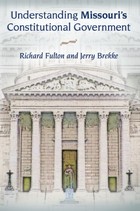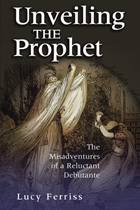203 books about Missouri and 2
start with U
203 books about Missouri and 2
203 books about Missouri
2 start with U start with U
2 start with U start with U

Understanding Missouri's Constitutional Government
Richard Fulton and Jerry Brekke
University of Missouri Press, 2010
In the study of American government, analysis of state governments is often neglected in favor of concentration on the national system. Certainly in-depth knowledge of our country’s constitutional structure is critical to an understanding of American government, but this continuing inattention to the complexities of state governments has left a hole in the literature available to help us understand the role state governments play in the federal system. State constitutions served as guides for the construction of the U.S. Constitution, but they have their own character and significance. As such, it is imperative that teachers, students, and historians fully understand the creation, administration, and adjudication of state governments.
Understanding Missouri’s Constitutional Government presents a case study in the foundations of state governments. The book provides a sweeping look at the constitutional foundations of the processes of Missouri government. Authors Richard Fulton and Jerry Brekke place Missouri within the context of our larger federal system while using the state’s constitution as a touchstone for the discussion of each element of state government.
Understanding Missouri’s Constitutional Government has a dual framework specifically designed to enhance the reader’s learning experience. First, the essential elements of government outlined in the constitution are introduced, and then analysis and interpretation of each of the document’s articles is covered. This organization permits readers to build an understanding of a particular element—for example, the legislature—by learning its fundamental organization, processes, and purposes in a straightforward manner. After gaining that primary perspective, the reader can use the formal analysis in the second section to explore interpretations of each article. Not only helpful to the general reader, this two-part structure makes the text especially useful in courses on American government, state and local governments, and particularly Missouri government and constitution.
In short, Understanding Missouri’s Constitutional Government is an approachable, valuable exposition on Missouri government as reflected in the day-to-day operations outlined in the Missouri constitution. It fills a significant gap in the literature on the interpretation, use, and operation of state constitutions. Since Missouri law dictates that all levels of education should teach government and constitution at the national and state levels, this book will be an indispensable resource for educators while serving as a valuable reference for journalists and public officials in the state.
Understanding Missouri’s Constitutional Government presents a case study in the foundations of state governments. The book provides a sweeping look at the constitutional foundations of the processes of Missouri government. Authors Richard Fulton and Jerry Brekke place Missouri within the context of our larger federal system while using the state’s constitution as a touchstone for the discussion of each element of state government.
Understanding Missouri’s Constitutional Government has a dual framework specifically designed to enhance the reader’s learning experience. First, the essential elements of government outlined in the constitution are introduced, and then analysis and interpretation of each of the document’s articles is covered. This organization permits readers to build an understanding of a particular element—for example, the legislature—by learning its fundamental organization, processes, and purposes in a straightforward manner. After gaining that primary perspective, the reader can use the formal analysis in the second section to explore interpretations of each article. Not only helpful to the general reader, this two-part structure makes the text especially useful in courses on American government, state and local governments, and particularly Missouri government and constitution.
In short, Understanding Missouri’s Constitutional Government is an approachable, valuable exposition on Missouri government as reflected in the day-to-day operations outlined in the Missouri constitution. It fills a significant gap in the literature on the interpretation, use, and operation of state constitutions. Since Missouri law dictates that all levels of education should teach government and constitution at the national and state levels, this book will be an indispensable resource for educators while serving as a valuable reference for journalists and public officials in the state.
[more]

Unveiling the Prophet
The Misadventures of a Reluctant Debutante
Lucy Ferriss
University of Missouri Press, 2005
In the autumn of 1972, Lucy Ferriss, then a college student in California, was preparing for the Veiled Prophet Ball at which she was to be presented to St. Louis society. Once the largest cotillion in the country, the invitation-only ball was unique among society events not only for the legend and mystery surrounding its namesake but also for its setting in a public, taxpayer-funded arena and for its accompanying parade.
In the late sixties and early seventies, with racial tensions at a boiling point and urban renewal failing, the exclusively white male Christian membership of the Veiled Prophet Society and the Veiled Prophet’s costume—eerily reminiscent of a Klansman’s—attracted the ire of ACTION, a militant civil rights group. Before the 1972 ball, ACTION founder Percy Green, himself a native St. Louisan, sent letters inviting all of the debutantes to join in the protest: “ACTION understands that you hate being part of this upcoming white racist Veiled Prophet Ball as we hate you being forced to participate by your parents.” The letter didn’t persuade Ferriss, who felt she owed it to her father to participate. She wrote back: “Don’t you have bigger fish to fry? This is just a stupid party. We are slaughtering people in Southeast Asia. Let this one go. It will fall of its own weight.”
But ACTION did not let this one go. On the night of the ball, as Ferriss bowed in obeisance to the crowd and took her place on the stage, a woman swooped down onto the stage and knocked off the Veiled Prophet’s hat and veil, revealing his identity. In the era of monumental Vietnam War protests, unmasking a wealthy and powerful old man might have seemed a feeble act of revolution, but this act forever changed the Veiled Prophet Ball in St. Louis.
Ferriss’s memoir blends regional history, national history, and her own personal history to create a fast-paced narrative that follows two time lines. One is the dramatic and often funny story of her attending the exclusive ball, having eaten half a pan of marijuana brownies beforehand, with a Jewish hippie who smelled of “unwashed beard.” The other story takes place thirty years later as Ferriss returns to St. Louis from her home on the East Coast to track down some of ACTION’s principal activists as well as key figures in the Veiled Prophet Society.
Over the course of this engaging story, Ferriss undergoes her own unveiling, as she discusses and comes to terms with her family; the past, present, and future of St. Louis; and the cultural politics that frame young women’s entrance into society.
[more]
READERS
Browse our collection.
PUBLISHERS
See BiblioVault's publisher services.
STUDENT SERVICES
Files for college accessibility offices.
UChicago Accessibility Resources
home | accessibility | search | about | contact us
BiblioVault ® 2001 - 2024
The University of Chicago Press









